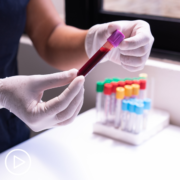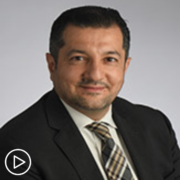How can you elevate your AML care and treatment? AML expert Dr. Gail Roboz discusses the importance of participating in AML treatment decisions, reviews key factors that may impact therapy options, and shares advice for advocating for yourself.
Related Resources:
Transcript:
Katherine Banwell:
Hello, and welcome. I’m your host, Katherine Banwell. It’s no secret that the quality-of-care patients receive can vary, and patients who are educated about their condition and involved in their care may have improved outcomes. That’s why the Patient Empowerment Network created the Elevate series, to help AML patients and their care partners feel well-informed when making treatment decisions with their healthcare team.
In today’s program, an AML expert will join us to share advice for accessing better overall care. Before we get into the discussion, please remember that this program is not a substitute for seeking medical advice. Please refer to your healthcare team about what might be best for you. Well, let’s meet our guest today. Joining us is Dr. Gail Roboz. Dr. Roboz, would you please introduce yourself?
Dr. Gail Roboz:
Absolutely. Thank you so much for having me. My name is Gail Roboz. I’m a professor of medicine and director of the clinical and translational leukemia programs at Weill Cornell Medicine and the NewYork-Presbyterian Hospital in New York City. Thank you again for having me.
Katherine Banwell:
Well, thank you so much for joining us today. We really appreciate it. I’d like to start by discussing your role as a researcher. You’re on the frontlines for advancements in the AML field. What led you here, and why is it important to you?
Dr. Gail Roboz:
So, I’m actually asked that question quite frequently, because AML is a challenging, difficult, scary disease, and people don’t necessarily assume that somebody in medical school would gravitate toward it.
But I have to say that what is incredibly fascinating back then and now about leukemia is the continuous access to the disease. Patients will maybe giggle or groan as I’m saying that, because you can get a blood sample really anytime. You can even get a bone marrow sample anytime, although patients don’t enjoy that so much.
But from a research perspective, it is absolutely extraordinary to be dealing with a disease where you can, in real time, truly run back and forth to a laboratory and see what’s happening, what is the new drug or the old drug doing, what’s happening with the patient, and I would say that from a fascination of a medical student perspective that grabbed me then and still does today.
Katherine Banwell:
When it comes to choosing therapy for AML, it’s important to work with your healthcare team to identify what will work best for you, the patient. So, I’d like to know how you define shared decision-making.
Dr. Gail Roboz:
The problem with AML sometimes is that it can be such an acute, emergency-type of presentation and urgent decision-making that I think your question is almost right out of the gate for some patients that will, “Wait, I don’t even have a minute, here. How do I build a team, do the research, look online if people are telling me that I’m in the middle of an emergency?”
That isn’t always the case for acute leukemia, but it sometimes is. I think that what happens in AML in particular for patients is a building of knowledge and a building of the team, and figuring out, first of all, where am I when I am being told this diagnosis, and is it really an emergency? Do I have to make decisions really right now, because is it life-threatening today, I don’t have time to look around? Or do I have a minute to pause and get more information?
I definitely feel that with the Internet era and with so much connection between doctors and teams, there is much more ability to reach out instantaneously for doctors, too, to get advice on a patient who might be in a smaller hospital that doesn’t have AML experience. But I think that the first thing is to try to figure out very, very quickly, what needs to happen to me as a patient immediately, and what can wait a minute, so that I can figure out what am I being told, and what are my options?
Katherine Banwell:
Right, right. It can be confusing for patients, just finding out this new information. Part of making care decisions is setting goals. What are AML treatment goals, and how are they determined?
Dr. Gail Roboz:
I would say that leaving cure on the table from the beginning is always a good place to start, because you want to figure out, first of all, what am I dealing with? What are the actual options?
But when AML strikes, and a patient who has multiple medical conditions or comorbidities that are truly compromising function independently of the diagnosis of AML, that’s going to be a special path of what is actually reasonable for someone who is terribly medically ill or otherwise frail right from the beginning? That can be defining goals, but I think from the beginning, the best thing is to leave everything on the table. What can actually be done to make me better, first of all, to get me out of my immediate trouble? What can be done to make me better, and if I’m getting better, well, I like that, how do I stay there?
What can be done to hang on to the state of ‘better,’ which is sometimes defined as remission? In AML, the goal is to get the bone marrow working again, functioning again, get rid of the acute emergency problem, if there is one, which there may or may not be in acute leukemia.
Sometimes it’s truly an emergency, and sometimes it isn’t. But once I get better, can I stay there? What is required to keep me with a working bone marrow for as long as possible?
But once you are starting to sort through the diagnosis, you realize that saying that somebody has acute myeloid leukemia is not telling me nearly enough information. This is a disease that is what we call biologically heterogeneous, which means there are lots of different forms. It’s like saying you’re sick. What exactly does that mean? There are lots of things that can make you sick. There are lots of different subtypes of AML, and fairly quickly in most institutions, we start getting back some information specifically on the subtype and biological characteristics of the disease.
This can be very, very important in the initial treatment planning, and depending on where you are, the information that you get back can sometimes take 24 hours, 48 hours, 72 hours, a week. So, you start learning very quickly though that, “If I’m not in a complete emergency that requires instantaneous treatment, can I get back more information about the biological subtype of the disease so that I can start treatment planning of what is my best option right out of the gate?” That’s usually called induction, or the first therapy that you’re going to get with the goal, ‘getting rid of leukemia cells and getting into remission.’ That’s part one, and then everything that comes after that is about keeping you in remission.
But for the initial goal, what is the therapy that the patient needs to get to get into remission? In order to figure that out, the good news is there are a lot of different ways to slice and dice getting into remission, and actually, it used to be such a weighty decision.
Now, I would actually encourage people to – not relax, you can never use the word ‘relax’ with acute leukemia. But there are several different induction strategies for most patients that would be okay.
So, even if you get started with one strategy and you hear five days later that another doctor might do something different, there are a lot of ways to safely get into remission. I think everybody should be pleased about the fact that we’re doing much better than we used to for patients across the board, all the way from children to much older adults, to safely getting people into remission.
Katherine Banwell:
Right. So, what sort of factors then do you take into consideration when you’re choosing a therapy?
Dr. Gail Roboz:
So, out of the gate, there are the patients that I think I referred to earlier who truly, truly are in situations based on their other diseases that there are certain treatments we would just cross out right out of the gate.
If there are patients with very, very severely compromised cardiac or renal or lung function or are terribly ill from other conditions, AML doctors will right out of the gate for those patients eliminate certain treatments. But absent that scenario, what we try to look for is the biology of the disease. Not look at the age, not look at the comorbidities unless they are so severe that they make obvious certain choices.
But rather, what I like to do is say, “What kind of AML is this, and what is the best treatment that I have to get this patient into remission?” And then ask the question, “can this particular patient handle this therapy?” Sometimes, these days, there actually may be more than one route to get to remission depending on the biology of the disease, and then, if that’s the case, then I can start getting picky and look at the individual patient. Where does the patient live? Who’s the patient’s family? What other diseases has the patient been treated for?
Is there something that I can use? If I have a choice, if there are a couple of different things that might work, how do I fit the treatment to best take care of the needs of this particular patient? If I don’t have choices, then my question is, “Okay, how do I get this patient through my one therapy that I think is the truly, truly best option?”
Katherine Banwell:
Okay. I’d like to turn to test results for a moment. What sort of tests should be done following an AML diagnosis?
Dr. Gail Roboz:
We often generally recommend a bone marrow biopsy, even if we know we can make the diagnosis from a blood test, because even though the bone marrow biopsy is not the most fun test in the world, it does offer better information for follow-up care than what you can get initially from the blood.
So, every once in a while, we do have a patient for whom a bone marrow biopsy itself for whatever reason can’t be done. But almost always, we need a bone marrow biopsy, and on that biopsy, you’re going to look under the microscope and see what the cells look like. You’re going to get back standard testing, which is called flow cytometry, which is going to tell the difference between what are the different cells that you’re seeing under the microscope.
But then you’re actually going to get progressively much more fancy testing, including things called chromosomes or cytogenetics, and then ultimately, the majority of patients, if at all possible, will be having mutational testing to identify certain subgroups of AML that benefit from very particular treatments. Next-generation sequencing, PCR, fusion proteins, FISH, cytogenetics, I can go on and on with all kinds of terminology that is very confusing, even to hematology fellows, let alone to patients.
Usually, we use a combination of tests to decide, “Is this patient likely to be able to be cured with chemotherapy alone, or might this patient benefit from a stem cell transplant from somebody else after they go into remission?”
That’s basically what the prognostic scoring systems used to be asking, but now it’s a lot more complicated than that. Because even in the favorable categories, even in the adverse categories, where there used to be very little subtlety, now there is a lot of subtlety.
It’s all about defining getting into remission, and what do I give you once you’re in remission to keep you there? It’s no longer this windshield wiper thing of good, bad, transplant, no transplant. There’s a lot more to AML than there used to be.
Katherine Banwell:
I’d like to add that if you, the viewer, are interested in learning more about AML testing and treatment, PEN has a number of resources available for you. You can find these at powerfulpatients.org/AML, or by scanning the QR code on your screen.
Before we get into specific treatment types, Dr. Roboz, would you provide a brief explanation of the phases of therapy for AML? You mentioned induction therapy earlier. Would you tell us what that is?
Dr. Gail Roboz:
Yeah. So, here, too, I have to say that it’s more confusing than it used to be for the following reasons. So, historically and currently, we typically talk about induction as the first therapy that you’re going to get to get into remission.
Then, the treatment paradigm is you do something to get into remission; do some treatment to get into remission. After that, in the realm of post-remission therapy, there are different things that can happen. There can be something called consolidation, which might be another round of chemotherapy. Some patients get consolidation, some patients don’t. After consolidation, there can be a transplant.
So, you get into remission, you may or may not get a little bit of what’s called consolidation chemotherapy, and then go on to a transplant.
However, sometimes either after the transplant or after chemotherapy before ever getting or instead of ever getting a transplant, there might be ongoing treatment in a lower intensity ongoing basis that is called maintenance.
So, you’ve got to think about it as induction as what happens first, consolidation is something that happens when you’re in remission, and then maintenance usually refers to ongoing therapy that is different from consolidation.
It’s usually lower intensity, easier to take, oral types of treatment that may go on and on. And just to be incredibly confusing, it’s different from something like breast cancer, where often the patients are given, “You get six cycles of this, and then you’re done.” From AML, there’s actually often not that type of an obvious plan right out of the gate for the patient.
The answer will be, “It depends.” It depends. It depends how your treatment looks at this point in time. It depends how you look at this point in time.
So then, the patients say, “Well, aren’t you going to cure me of this? What are you doing? Aren’t you going to get rid of it?” So, historically, there are some patients who get cured with chemotherapy. They get chemotherapy to get into remission, they get some chemotherapy afterwards, and there’s a cure rate for some patients with that. The majority of patients who are cured with AML get an allotransplant, or a transplant from somebody else.
Then there’s a whole group of patients where we’re asking the question now, is it possible to get those patients beyond five years – so in oncology, five years is typically defined as cure. Can we get some patients with ongoing therapy to that past-five-year mark without a transplant? That’s in the zone of the ‘coming soon.’ Don’t have a ton of patients in that group right now, but hopefully we will.
Katherine Banwell:
You’ve mentioned some various treatment types that are used to treat AML. Can you share a brief overview of available treatments?
Dr. Gail Roboz:
So, the terminology that we use is a little bit annoying, because it is a little bit general. We say intensive and not intensive.
But historically, intensive chemotherapy referred to a combination of generally two types of agents, cytarabine (Cytosar-U) and an anthracycline, which is a class of chemotherapy, that either just those two together or in combination with sometimes a third or a fourth drug usually keeps people in the hospital for around a month. Not that the chemotherapy takes that long, but the treatment gets rid of basically a lot of cells in the bone marrow, good guys and bad guys, and it takes about three weeks for those normal cells to recover.
So, a standard intensive induction for AML is often around three to four weeks in the hospital, somewhere between three and five or so days of chemotherapy up front, depending on exactly what the protocol is. The classic regimen is actually still called 3+7, three days of one drug, seven of the other. But there are many variations of that that work.
The chemo is then stopped, the patient hangs out in the hospital, very frequently getting transfusions and antibiotics, and we wait for the bone marrow to recover.
Another current path that many patients are getting – almost all older patients, with ‘older’ being defined not by a specific age cutoff, but often 75 and older, almost everybody agrees no longer gets the classic chemotherapy that I just described. At some institutions, that 75 is going down, and even 70 and 65 and above are getting a new type of therapy, mostly because the new type of therapy is working pretty well. That is a combination of something called a hypomethylating agent.
Drugs like azacitidine (Vidaza, Onureg) or decitabine (Dacogen) in combination with a pill that has changed the landscape of AML more than any other called venetoclax (Venclexta). Venetoclax is a drug that is not exclusively used for AML.
It actually was originally approved for another type of leukemia. But I think that not many people would argue with the statement that what has changed absolutely the face of AML treatment has been this drug, because it’s a BCL2 inhibitor. What it does is it actually – cancer cells and leukemia cells in particular are very, very good at staying alive.
They don’t undergo cell death, they don’t want to die, and venetoclax brings down their forcefield so that those cells can actually undergo apoptosis and die.
Venetoclax in combination with azacitidine or decitabine has transformed the care of the disease, because many patients older than 65 – and the median age of diagnosis of AML is around 68 to 70. So, many patients never were well enough to have the intensive therapy. They weren’t going into remission, and they weren’t having prolonged survival often beyond a few months.
But now, those patients do actually much better with the combination of aza [azacitidine] and venetoclax. So typically, the induction path is going to be deciding who gets an intensive therapy backbone, usually associated with long hospitalization. Who gets a less intensive backbone – by the way, that is often associated with just the same hospitalization. So, that’s why I don’t love the term ‘low intensity,’ because that implies that it doesn’t work.
It does, and it also implies that you’re not going to be in the hospital. You probably will, because in the same way as for the more so-called intensive therapies, getting into remission involves getting rid of bone marrow cells and waiting for the normal ones to recover. Even if you are a patient who is getting the venetoclax combined with the azacitidine or decitabine, which is typically called low intensity, you may very well be in the hospital for a month.
Because depending on where you live and who your family is and how sick you might be, you will probably want us to watch you carefully during that first month, but it’s worth it. Because if you have a good chance of getting into remission, remission is what makes life better and life longer. So, we want to get patients into remission, even if it means upfront time in the hospital.
Katherine Banwell:
You mentioned one inhibitor as targeted therapy, but there are a couple of others. Would you briefly tell us about those?
Dr. Gail Roboz:
So, over the years recently, we have identified certain specific targets in AML which are resulting in the addition of medications on these standard backbones. So, the target for venetoclax is something called BCL2, and actually, venetoclax probably makes all chemotherapy better. It’s kind of a controversial statement, but I’m going to stand by it. But in AML, it has been shown that the addition of venetoclax to lots of different backbones makes them work better. There are other things to hit, though.
For example, there are patients with AML who have something called a FLT3, F-L-T-3 mutation. This mutation also has specific inhibitors that are FDA-approved drugs that target specifically the FLT3 mutation, and if you have one of those, your doctor may add on a FLT3 inhibitor to either a lower intensity or an intensive backbone. Similarly, there are agents called IDH inhibitors. There are IDH1 and IDH2 inhibitors.
If I start getting into isocitrate dehydrogenase pathways on this webinar, I think everybody will click off, because it’s certainly bored all of the medical students in med school, and it’s pretty tough to understand. But the bottom line is it’s very cool stuff because that boring pathway in medical school that nobody really thought about too much is actually part of very, very, central cellular functions that are a vulnerability now that have been identified in leukemic cells that, if you hit them with these specific inhibitors, patients do better.
Now, couple of things for patients. It doesn’t mean that it’s better to have a FLT3 or an IDH mutation because the targeted therapies are available. So, a lot of patients are disappointed when they don’t have mutations. I don’t want you to think in that way. It’s not that it’s better, it’s different.
It identifies a different biology. If you have certain mutations, there are certain medications that may help you more.
That’s why I think the patients are learning quickly, too, to ask the doc – they may not remember the letters of the alphabet soup, but “Do I have something about my AML that can get one of these targeted therapies added on?” I think is a good question to think about. “Do I have something about my disease that has a specific drug that we’ve already learned makes outcomes better?”
Katherine Banwell:
There’s a new emerging therapy as well. Is it the menin inhibitor?
Dr. Gail Roboz:
I think that, in understanding different targets and different pathways, it leads me to a general statement that if you can get yourself potentially onto a clinical trial at an academic center, that is something to consider right out of the gate. Because there is a lot, a lot, a lot going on in this field right now.
What we are hoping, and the reason that I am talking to you about venetoclax and FLT3 inhibitors and IDH inhibitors, is because of all the patients who jumped onto those clinical trials and proved that those drugs are better. Some of them are my patients! I was fortunate on some of those early trials to have some real winners in patients who got onto the trials. They’re the ones who drove the success.
So, for example, menin inhibitors, which are very, very exciting, targeted agents for NPM1 and KMT2A mutations and rearrangements – these are complicated to remember as a patient, but there’s a cool drug out there that might be for you. I think that patients who really think about asking the question wherever they are, the “Hey, I just got a diagnosis of AML. Is there a clinical trial that might look good for me?” I think is a great question to ask pretty much out of the gate.
Katherine Banwell:
The symptoms of AML as well as the side effects of certain medications can vary greatly among patients. So, how do you approach symptom management with your patients?
Dr. Gail Roboz:
Patients will giggle because I repeat this line. You have to be afraid of the disease, not the treatment. I think that if you read the package insert on a Tylenol, you’re certainly not going to think you’re going to live for more than 20 minutes if you take one of those. You can certainly appreciate that, with chemotherapy drugs and including some of the novel agents that I’m talking about, if you read package inserts and look at some of the signs and symptoms and things that can happen, it’s extraordinarily overwhelming.
I think that a lot of what I do for patients is I keep them close. Because if the patient is in the hospital or coming in very frequently in clinic, I think that that everyday assessment of, “What are you experiencing?” and “What can I tell you is the disease’s fault, and what can I tell you is the medication’s fault?” is so, so important.
Especially in the newly diagnosed patients, where the disease is active. Of course, we want to try to minimize anything that we can do to make the process better for patients, more comfortable for patients, but there are certain things that we do tell people, “You’ve got to slug through this particular problem, because this is the disease’s fault.” This is different from a patient in remission, where they might be getting ongoing therapy with something, or we say, “Hey, wait a minute. You’d be feeling fine, except now you’re taking this medication. How do we minimize messing up quality of life in remission?”
Because we want you to feel great when you’re in remission. I think the real answer of that is to have a really close collaboration with the healthcare team, and for the patients to really understand – I repeat this because it’s so important. What is the disease’s fault, and what is the treatment’s fault? If there’s something that is therapy-related, do I have a substitute or do I not have a substitute?
Because if the drug is essential to get us where we need to go, well, what can we do to manage comfort and to manage symptoms until you get to the place where your marrow is working again?
Katherine Banwell:
That’s great advice, Dr. Roboz. I would like to get to an audience question that we received prior to the program. This one comes from Johanna. “How can I better understand my lab test results? What questions should I be asking my provider about those results?”
Dr. Gail Roboz:
One of the things that I would say to patients is to be careful when interpreting your own results, because I really am not exaggerating to say that patients have had absolute trauma looking at things that I look at it and say, “Oh, this looks great.” So, the first thing is, be careful being your own doctor.
The second thing though is that the author of the question has to understand that there’s going to be a tsunami of data coming in with respect to AML treatment. Sometimes in the hospital on a daily basis when you’re in the middle of an induction, there is a true – tsunami is the right word – a deluge of data, and you have to work with your team to say, “What am I following here? What’s important at this phase in my treatment? What’s the number I’m looking at?” Patients sometimes tell me, “I don’t want to know any of this,” and I’m fine with that.
I think it’s actually okay. Sometimes patients will say, “Give me guidance,” and I will be specific. Because you can actually have a leukemia induction patient where every single laboratory value is abnormal. They might be getting pushed to a device, in the morning, sitting in the hospital on your iPad, 50 abnormal results. You’re trying to battle back the disease and be positive and advocate for yourself, but there are 50 abnormal results in front of you.
I think you have to really work with the team to say, “What am I looking at today? What are the numbers that are the really important ones? There are 50 abnormal ones here; everything is getting a yellow or a red light in this. How do I go through this?”
And to appreciate, also, that at different points in the treatment, the beginning of treatment induction post-remission therapy, you’re looking for different things. So, work with your team so that you’re not assessing every single result with equivalent weight, because I think you’re going to stress yourself out.
Katherine Banwell:
That’s great advice, Dr. Roboz. Thank you. As we close out the program, I’d like to find out what you would like to leave the audience with. Why are you hopeful?
Dr. Gail Roboz:
AML is changing incredibly rapidly. And I can tell you it is a lot more fun to be an AML doctor now than it used to be, with respect to what I am offering for patients. We have always fought really, really hard to have our wins, but we’re winning more. I do think that it is a complicated space to navigate for patients, but there is room for a lot of optimism.
I think we are getting patients transplanted – patients that we never thought would ever go through a transplant or getting transplanted. Patients who never had a chance of even living more than six or eight months or living much longer than that. Is it perfect? No. Do we have as many cures as we want?
No, but there’s a lot going on. I think if patients feel that excitement, they will also feel the need to ask about those clinical trials. Because I think that for a lot of patients, clinical trials is an area where they would be worried. They’re not sure that they want to. “I don’t want to be a guinea pig,” and yet here I can say in the AML space, one after another after another drug approvals in the last several years, with the patients on those trials being awfully happy that they participated.
So, I think that it’s a very, very terrifying diagnosis. There’s nothing that I can do to take the sting out of that. But try to find yourself in an optimistic place with options that are being offered to the very, very, very best that we can do. There are patients who are listening, I’m sure, who have relapsed or refractory disease who are not feeling that optimism.
I want to address you specifically, because we don’t have enough yet. We’re trying. When you have AML that has come back or come back multiply, that’s dangerous and difficult. But for those patients in particular, try really hard to get onto clinical trials. If the drugs that we have out there – if you’ve already taken them and they haven’t worked for you or if they’re not serving you well, if you’re in good shape and the drugs that we have aren’t good enough, well, let’s see if we can get you on something that’s investigational.
Katherine Banwell:
Dr. Roboz, thank you so much for taking the time to join us today.
Dr. Gail Roboz:
Thank you for having me.
Katherine Banwell:
I also want to thank all of our collaborators. To learn more about AML and to access tools to help you become a proactive patient, visit powerfulpatients.org. I’m Katherine Banwell. Thanks for joining us today.


























